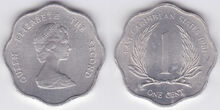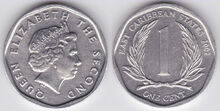- For the coin of the British West Indies, see British West Indies 1 cent coin.
| Cent | |||
|---|---|---|---|

| |||
| 2004 coin | |||
| General information | |||
| Country |
| ||
| Value |
EC$0.01 | ||
| Years |
1981–2013 | ||
| Measurements and composition | |||
| Mass |
| ||
| Diameter |
18.4 mm | ||
| Thickness |
| ||
| Composition | |||
| Appearance | |||
| Shape |
| ||
| Alignment |
medallic | ||
| Edge |
plain | ||
| Obverse |
Elizabeth II, monarch title | ||
| Reverse |
Palm fronds, title, value, year | ||
| v · d · e | |||
The 1 cent coin is a current circulation piece of the East Caribbean dollar. It was issued in two types by the Eastern Caribbean Central Bank (ECCB) and its precursor, the Eastern Caribbean Currency Authority (ECCA), from 1981 to 2013. Lacking mints of their own, the ECCB and ECCA outsourced production of the coin to the Royal Mint from 1981 to 2008 and the Royal Canadian Mint from 2011 to 2013.
The first 1 cent piece was released in 1982 (although dated 1981) and manufactured annually until 2000. It was followed in 2002 by a second coin of the denomination, which remained in production until its discontinuation in 2013.
Although both coins currently hold a legal tender face value of 0.01 dollars in Anguilla, Antigua and Barbuda, Dominica, Grenada, Montserrat, Saint Kitts and Nevis, Saint Lucia, and Saint Vincent and the Grenadines, they no longer circulate frequently due to their low purchasing power. They began to be withdrawn from circulation in July 2015, and will remain valid until their demonetization on June 30, 2020.
Coins[]
Scalloped coin (1981–2000)[]

1981 coin
The East Caribbean dollar was introduced in 1965, replacing the previous British West Indies dollar at par in Antigua and Barbuda, Barbados, British Guiana, Dominica, Montserrat, Saint Christopher-Nevis-Anguilla, Saint Lucia, and Saint Vincent and the Grenadines. Barbados and British Guiana (now independent Guyana) respectively stopped using the East Caribbean dollar in 1966 and 1972. The currency was eventually adopted by Grenada in 1968, and by Anguilla and Saint Christopher and Nevis (now independent Saint Kitts and Nevis), which had previously been part of Saint Christopher-Nevis-Anguilla, in 1980.
During the 17-year interval from 1965 to 1982, no circulation coins of the currency were introduced. Instead, the 1, 2, 5, 10, 25, and 50 cent pieces of the British West Indies dollar, last minted in 1965, continued to circulate. They were ultimately withdrawn in 1981, and replaced in 1982 by the first coins of the East Caribbean dollar. Consisting of denominations of 1, 2, 5, 10, and 25 cents and 1 dollar, the entire six-coin series was struck at the Royal Mint until 2000.
The 1 cent piece is composed of aluminum and measures 0.8 grams in mass, 18.4 millimeters in diameter, and 1.4 millimeters in thickness. It has medallic alignment; raised, undecorated rims; and a plain edge. Unlike most coins, the piece is scalloped in shape, having eight rounded notches.
A younger portrait of Elizabeth II (1926–), the reigning monarch of the United Kingdom and the Commonwealth realms, is illustrated in the center of the obverse. Initially designed by sculptor Arnold Machin (1911–1999) in 1964, this depiction shows the queen facing right and wearing the Girls of Great Britain and Ireland Tiara, one of her most recognizable pieces of jewelry, on her head. The English legend "QUEEN ELIZABETH THE SECOND" accompanies the illustration, traveling clockwise from the piece's lower left to lower right peripheries.
The reverse's designs incorporate elements used on the 1 and 2 cent pieces of the British West Indies dollar, which were originally designed by sculptor Thomas Humphrey Paget (1893–1974) around 1955. A large numeral "1" is engraved in the center, and is partially surrounded by a wreath consisting of two tied palm fronds. Inscribed clockwise along the periphery above is the legend "EAST CARIBBEAN STATES" and Gregorian date of minting. Printed in the opposite direction at the rim below is the written face value, "ONE CENT".
Over 16 years of production, a large number of business strikes and a handful of uncirculated and proof pieces were manufactured. The uncirculated and proof examples were sold exclusively in mint and proof sets, whereas most of the business strikes eventually entered circulation. Total mintage figures for all years of production are currently unknown.
| Years | |
|---|---|
| Year | Mintage |
| 1981 | |
| 1981 Proof | 5,000 |
| 1983 | |
| 1984 | |
| 1986 | |
| 1986 Proof | 2,500 |
| 1987 | |
| 1989 | |
| 1991 | |
| 1992 | |
| 1993 | |
| 1994 | |
| 1995 | |
| 1996 | |
| 1997 | |
| 1998 | |
| 1999 | |
| 2000 | |
Round coin (2002–2013)[]

2002 coin
In 2002, two significant changes were made to the circulation coins of the East Caribbean dollar. An updated portrait of Queen Elizabeth II, initially designed by British sculptor Ian Rank-Broadley (1952–) in 1997, started to appear on the obverse of the East Caribbean pieces. In addition, round 1, 2, and 5 cent coins began circulating on August 8, followed shortly thereafter by a round 1 dollar piece. Because coin counting machines on the East Caribbean islands were primarily designed for round coins, this change greatly benefited commercial banks using such devices. The coins were manufactured at the Royal Mint from 2002 to 2008, and then at the Royal Canadian Mint beginning in 2010.
The round 1 cent piece, which was struck intermittently until 2013, is composed of aluminum and measures 1.03 grams in mass, 18.4 millimeters in diameter, and 2 millimeters in thickness. It has medallic alignment, a plain edge, and raised rims on both sides. These rims form the outline of an eight-notched scallop, the same shape as the 1 cent coin issued until 2000.
Ian Rank-Broadley's portrait of a 70-year-old Elizabeth II is displayed in the middle of the piece's obverse. In this illustration, the British monarch is portrayed facing right, wearing the Girls of Great Britain and Ireland Tiara on her head. The English caption "QUEEN ELIZABETH THE SECOND" accompanies this depiction, traveling clockwise from the piece's lower left to lower right rims, while the "IRB" initials of the artist are engraved in small print below her likeness.
A large numeral "1" is featured in the center of the reverse, where it is partially surrounded by a wreath of tied palm fronds. Engraved clockwise along the periphery above is the legend "EAST CARIBBEAN STATES" and the Gregorian date of minting, and printed in the opposite direction at the rim below is the written face value, "ONE CENT".
Mintage figures for the piece are currently unavailable. Only business strikes of this particular type are known to exist.
| Years | |
|---|---|
| |
References[]
- Numismatic Guaranty Corporation – East Caribbean States – Cent, KM# 10 (1981–2001) • East Caribbean States – Cent, KM# 34 (2002–2011)
- Colnect – 1 Cent (1981–2000) • 1 Cent (2002–2013)
- Numista – 1 Cent (1981–2001) • 1 Cent (2002–2013) (English) (French)
- Eastern Caribbean Central Bank – Current Circulation Coins • Withdrawal of 1 and 2 Cent Coins • Numismatic Collections
- Montserrat Reporter – "Eastern Caribbean Central Bank Issue Set of New Round Coins"
East Caribbean dollar on the English Wikipedia
Template:East Caribbean dollar
